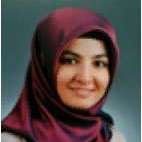
Bahar Nazli
Work place: Department of Biomedical Engineering, Kastamonu University, Kastamonu, Turkey
E-mail: bnazli@kastamonu.edu.tr
Website:
Research Interests: Computer Architecture and Organization, Computational Learning Theory
Biography
Bahar Nazlı is currently working as Research Assistant of Biomedical Engineering Department at Kastamonu University, Kastamoun/Turkey. She has completed her B.Sc degree in Biomedical Engineering Department from Erciyes University. She continues M.Sc. degree in Biomedical Engineering Department at Kastamonu University. Her research is in the field of signal processing and machine learning.
Author Articles
Classification of Coronary Artery Disease Using Different Machine Learning Algorithms
By Bahar Nazli Yasemin Gultepe Hayriye Altural
DOI: https://doi.org/10.5815/ijeme.2020.04.01, Pub. Date: 8 Aug. 2020
Coronary Artery Disease (CAD) takes place in the category of fatal diseases resulting in death in our country and around the world. Each year about 340 thousand patients lost their lives due to CAD in Turkey. Early diagnosis is essential to reduce risk and prolong lifetime of these patients for diseases that require long-term treatment having death risk like CAD. For this reason, classification of CAD by using medical data processing and machine learning algorithms are important in order to develop assistive or expert systems for physicians. In this study, five different machine learning algorithms were applied to estimate whether patients in the Z-Alizadeh Sani data set extracted from the UCI machine learning pool are CAD. Accuracy, precision, recall, specificity and F1 score were compared as classification performance indicators to evaluate decision tree, random forest (RF), support vector machines (SVM), nearest neighborhood (k-NN) and multi-layer sensor (MLP) methods. According to the evaluation results, the MLP method gave high classification accuracy with 90%. It also appears that RF performs relatively better than other metrics. This results, show that these classification algorithms can be use for helping healthcare systems.
[...] Read more.Other Articles
Subscribe to receive issue release notifications and newsletters from MECS Press journals